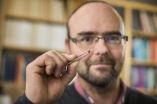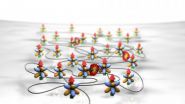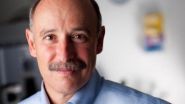(Press-News.org) A University of Alberta diamond scientist has found the first terrestrial sample of a water-rich gem that yields new evidence about the existence of large volumes of water deep beneath the Earth.
An international team of scientists led by Graham Pearson, Canada Excellence Research Chair in Arctic Resources at the U of A, has discovered the first-ever sample of a mineral called ringwoodite. Analysis of the mineral shows it contains a significant amount of water—1.5 per cent of its weight—a finding that confirms scientific theories about vast volumes of water trapped 410 to 660 kilometres beneath the Earth, between the upper and lower mantle.
"This sample really provides extremely strong confirmation that there are local wet spots deep in the Earth in this area," said Pearson, a professor in the Faculty of Science, whose findings were published March 13 in Nature. "That particular zone in the Earth, the transition zone, might have as much water as all the world's oceans put together."
Ringwoodite is a form of the mineral peridot, believed to exist in large quantities under high pressures in the transition zone. Ringwoodite has been found in meteorites but, until now, no terrestrial sample has ever been unearthed because scientists haven't been able to conduct fieldwork at extreme depths.
Pearson's sample was found in 2008 in the Juina area of Mato Grosso, Brazil, where artisan miners unearthed the host diamond from shallow river gravels. The diamond had been brought to the Earth's surface by a volcanic rock known as kimberlite—the most deeply derived of all volcanic rocks.
The discovery that almost wasn't
Pearson said the discovery was almost accidental in that his team had been looking for another mineral when they purchased a three-millimetre-wide, dirty-looking, commercially worthless brown diamond. The ringwoodite itself is invisible to the naked eye, buried beneath the surface, so it was fortunate that it was found by Pearson's graduate student, John McNeill, in 2009.
"It's so small, this inclusion, it's extremely difficult to find, never mind work on," Pearson said, "so it was a bit of a piece of luck, this discovery, as are many scientific discoveries."
The sample underwent years of analysis using Raman and infrared spectroscopy and X-ray diffraction before it was officially confirmed as ringwoodite. The critical water measurements were performed at Pearson's Arctic Resources Geochemistry Laboratory at the U of A. The laboratory forms part of the world-renowned Canadian Centre for Isotopic Microanalysis, also home to the world's largest academic diamond research group.
The study is a great example of a modern international collaboration with some of the top leaders from various fields, including the Geoscience Institute at Goethe University, University of Padova, Durham University, University of Vienna, Trigon GeoServices and Ghent University.
For Pearson, one of the world's leading authorities in the study of deep Earth diamond host rocks, the discovery ranks among the most significant of his career, confirming about 50 years of theoretical and experimental work by geophysicists, seismologists and other scientists trying to understand the makeup of the Earth's interior.
Scientists have been deeply divided about the composition of the transition zone and whether it is full of water or desert-dry. Knowing water exists beneath the crust has implications for the study of volcanism and plate tectonics, affecting how rock melts, cools and shifts below the crust.
"One of the reasons the Earth is such a dynamic planet is the presence of some water in its interior," Pearson said. "Water changes everything about the way a planet works."
INFORMATION:
Water-rich gem points to vast 'oceans' beneath the Earth: UAlberta study
2014-03-12
ELSE PRESS RELEASES FROM THIS DATE:
Quantum chaos in ultracold gas discovered
2014-03-12
The team of Francesca Ferlaino, Institute for Experimental Physics of the University of Innsbruck, Austria, has experimentally shown chaotic behavior of particles in a quantum gas. "For the first time we have been able to observe quantum chaos in the scattering behavior of ultracold atoms," says an excited Ferlaino. The physicists used random matrix theory to confirm their results, thus asserting the universal character of this statistical theory. Nobel laureate Eugene Wigner formulated random matrix theory to describe complex systems in the 1950s. Although interactions ...
Key heart-failure culprit discovered
2014-03-12
SAN DIEGO, Calif., March 12, 2014 - A team of cardiovascular researchers from Sanford-Burnham Medical Research Institute (Sanford-Burnham), the Cardiovascular Research Center at Icahn School of Medicine at Mount Sinai, and the University of California, San Diego have identified a small but powerful new player in the onset and progression of heart failure. Their findings, published in the journal Nature on March 12, also show how they successfully blocked the newly discovered culprit to halt the debilitating and chronic life-threatening condition in its tracks.
In the ...
Protein key to cell motility has implications for stopping cancer metastasis
2014-03-12
VIDEO:
Aberrant filopodia are induced by co-expression of fluorescently labeled Cdc42 and non-fluorescent IRSp53. Fluorescence shows the cell shape, because Cdc42 localizes to the plasma membrane.
Click here for more information.
PHILADELPHIA - "Cell movement is the basic recipe of life, and all cells have the capacity to move," says Roberto Dominguez, PhD, professor of Physiology at the Perelman School of Medicine, University of Pennsylvania. Motility – albeit on a cellular spatial ...
Countering the caregiver placebo effect
2014-03-12
How do you know that your pet is benefiting from its pain medication? A new clinical trial design from North Carolina State University researchers could help overcome pet owners' unconscious observation bias and determine whether the drugs they test are effective.
When animals are recruited for clinical trials, particularly for pain medications, researchers must rely on owner observation to determine whether the medication is working. Sounds simple enough, but as it turns out, human and animal behavior can affect the results.
All clinical trials have a "control" ...
'Ultracold' molecules promising for quantum computing, simulation
2014-03-12
WEST LAFAYETTE, Ind. – Researchers have created a new type of "ultracold" molecule, using lasers to cool atoms nearly to absolute zero and then gluing them together, a technology that might be applied to quantum computing, precise sensors and advanced simulations.
"It sounds counterintuitive, but you can use lasers to take away the kinetic energy, resulting in radical cooling," said Yong P. Chen, an associate professor of physics and electrical and computer engineering at Purdue University.
Physicists are using lasers to achieve such extreme cooling, reducing the temperature ...
Turing's theory of morphogenesis validated 60 years after his death
2014-03-12
PITTSBURGH—British mathematician Alan Turing's accomplishments in computer science are well known—he's the man who cracked the German Enigma code, expediting the Allies' victory in World War II. He also had a tremendous impact on biology and chemistry. In his only paper in biology, Turing proposed a theory of morphogenesis, or how identical copies of a single cell differentiate, for example, into an organism with arms and legs, a head and tail.
Now, 60 years after Turing's death, researchers from the University of Pittsburgh and Brandeis University have provided the ...
Large study identifies the exact gut bacteria involved in Crohn's disease
2014-03-12
While the causes of Crohn's disease are not well understood, recent research indicates an important role for an abnormal immune response to the microbes that live in the gut. In the largest study of its kind, researchers have now identified specific bacteria that are abnormally increased or decreased when Crohn's disease develops. The findings, which appear in the March 12 issue of the Cell Press journal Cell Host & Microbe, suggest which microbial metabolites could be targeted to treat patients with this chronic and currently incurable inflammatory bowel disease.
Twenty-eight ...
Newly diagnosed Crohn's disease patients show imbalance in intestinal microbial population
2014-03-12
A multi-institutional study led by investigators from Massachusetts General Hospital (MGH) and the Broad Institute has identified how the intestinal microbial population of newly diagnosed Crohn's disease patients differs from that of individuals free of inflammatory bowel disease (IBD). In their paper in the March 12 issue of Cell Host and Microbe, the researchers report that Crohn's patients showed increased levels of harmful bacteria and reduced levels of the beneficial bacteria usually found in a healthy gastrointestinal tract.
Several studies have suggested that ...
Missing link in plant immunity identified
2014-03-12
After a 30-year search, scientists have uncovered how an enzyme critical to plants' rapid immune response against microbes is activated.
"The insights will open up new ways to improve disease resistance and stress tolerance in plants," says Professor Cyril Zipfel of The Sainsbury Laboratory in Norwich.
The enzyme, the NAPDH oxidase RBOHD, triggers a rapid generation of signalling molecules derived from oxygen that are believed to be detrimental to microbial growth. The newly-discovered way this enzyme is activated, by a protein (called BIK1) fills a gap in how plants ...
Microbes help to battle infection
2014-03-12
The human relationship with microbial life is complicated. At almost any supermarket, you can pick up both antibacterial soap and probiotic yogurt during the same shopping trip. Although there are types of bacteria that can make us sick, Caltech professor of biology and biological engineering Sarkis Mazmanian and his team are most interested in the thousands of other bacteria—many already living inside our bodies—that actually keep us healthy. His past work in mice has shown that restoring populations of beneficial bacteria can help alleviate the symptoms of inflammatory ...





